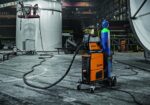Kemppi adds Pulse model to X5 FastMig welding range
Leading international welding equipment manufacturer, Kemppi, has released its latest addition to its range of X5 FastMig welders – the new X5 FastMig Pulse. The X5 FastMig Pulse multi-process welding system has been specifically designed for steel, aluminium and stainless steel welding in industrial environments. The machine delivers a range of features that help significantly enhance arc welding productivity. Built using energy-efficient inverter technology, the X5 FastMig Pulse offers faster welding and quality welds thanks to Touch Sense Ignition, effortless operation, excellent welding ergonomics, flexible equipment setup and is industry 4.0 ready. Faster welding, better quality weldsA high-performing machine, the X5 FastMig Pulse features the latest in ignition technology – Touch Sense Ignition – as standard. When combined with WiseSteel software, which is also included in the X5 FastMig Pulse, it delivers precise ignition capability and stable arc control. The X5 Pulse tackles the challenges of globular arc by alternating between short arc and spray transfer. In short-circuit transfer, it improves the arc stability adaptively, providing better out-of-position steel welding capabilities. In spray transfer mode, micropulsing of the current and voltage increases travel speed significantly. In doing so, the X5 Pulse helps to minimise the spatter produced by a traditional globular arc, as well as the need for post weld cleaning, saving the welder both valuable time and cost, while helping to deliver better quality welds. For more challenging steel, stainless steel and aluminium applications, the arc control can be further optimised with optional MAX welding programs and Wise special processes. Effortless operationDesigned to be hassle-free, the new model can be quickly set up thanks to Weld Assist. This feature guides the welder to set the right parameters for each application so they can start welding faster. The X5 Pulse is also very easy to operate. It features a large, graphical […]










